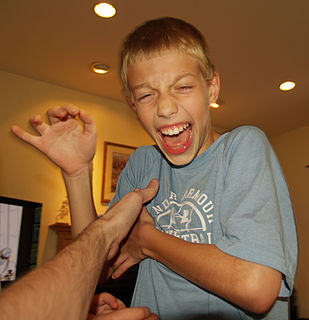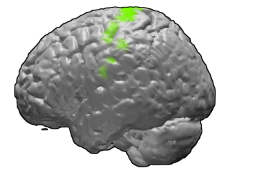Related Research Articles
Phonetics is a branch of linguistics that studies how humans produce and perceive sounds, or in the case of sign languages, the equivalent aspects of sign. Phoneticians—linguists who specialize in phonetics—study the physical properties of speech. The field of phonetics is traditionally divided into three sub-disciplines based on the research questions involved such as how humans plan and execute movements to produce speech, how various movements affect the properties of the resulting sound, or how humans convert sound waves to linguistic information. Traditionally, the minimal linguistic unit of phonetics is the phone—a speech sound in a language—which differs from the phonological unit of phoneme; the phoneme is an abstract categorization of phones.

The putamen is a round structure located at the base of the forebrain (telencephalon). The putamen and caudate nucleus together form the dorsal striatum. It is also one of the structures that compose the basal nuclei. Through various pathways, the putamen is connected to the substantia nigra, the globus pallidus, the claustrum, and the thalamus, in addition to many regions of the cerebral cortex. A primary function of the putamen is to regulate movements at various stages and influence various types of learning. It employs GABA, acetylcholine, and enkephalin to perform its functions. The putamen also plays a role in degenerative neurological disorders, such as Parkinson's disease.

Apraxia is a motor disorder caused by damage to the brain which causes difficulty with motor planning to perform tasks or movements. The nature of the damage determines the disorder's severity, and the absence of sensory loss or paralysis helps to explain the level of difficulty. Children may be born with apraxia; its cause is unknown, and symptoms are usually noticed in the early stages of development. Apraxia occurring later in life, known as acquired apraxia, is typically caused by traumatic brain injury, stroke, dementia, Alzheimer's disease, brain tumor, or other neurodegenerative disorders. There are multiple types of apraxia, categorized by the specific ability and/or body part affected.
A motor skill is a function that involves specific movements of the body's muscles to perform a certain task. These tasks could include walking, running, or riding a bike. In order to perform this skill, the body's nervous system, muscles, and brain have to all work together. The goal of motor skill is to optimize the ability to perform the skill at the rate of success, precision, and to reduce the energy consumption required for performance. Performance is an act of executing a motor skill or task. Continuous practice of a specific motor skill will result in a greatly improved performance, which leads to Motor Learning. Motor learning is a relatively permanent change in the ability to perform a skill as a result of continuous practice or experience.
Dysarthria is a speech sound disorder resulting from neurological injury of the motor component of the motor–speech system and is characterized by poor articulation of phonemes. In other words, it is a condition in which problems effectively occur with the muscles that help produce speech, often making it very difficult to pronounce words. It is unrelated to problems with understanding language, although a person can have both. Any of the speech subsystems can be affected, leading to impairments in intelligibility, audibility, naturalness, and efficiency of vocal communication. Dysarthria that has progressed to a total loss of speech is referred to as anarthria. The term dysarthria is from New Latin, dys- "dysfunctional, impaired" and arthr- "joint, vocal articulation".

The motor cortex is the region of the cerebral cortex involved in the planning, control, and execution of voluntary movements. Classically, the motor cortex is an area of the frontal lobe located in the posterior precentral gyrus immediately anterior to the central sulcus.
Motor control is the regulation of movement in organisms that possess a nervous system. Motor control includes reflexes as well as directed movement.

In the scientific study of vision, smooth pursuit describes a type of eye movement in which the eyes remain fixated on a moving object. It is one of two ways that visual animals can voluntarily shift gaze, the other being saccadic eye movements. Pursuit differs from the vestibulo-ocular reflex, which only occurs during movements of the head and serves to stabilize gaze on a stationary object. Most people are unable to initiate pursuit without a moving visual signal. The pursuit of targets moving with velocities of greater than 30°/s tends to require catch-up saccades. Smooth pursuit is asymmetric: most humans and primates tend to be better at horizontal than vertical smooth pursuit, as defined by their ability to pursue smoothly without making catch-up saccades. Most humans are also better at downward than upward pursuit. Pursuit is modified by ongoing visual feedback.
Motor coordination is the orchestrated movement of multiple body parts as required to accomplish intended actions, like walking. This coordination is achieved by adjusting kinematic and kinetic parameters associated with each body part involved in the intended movement. The modifications of these parameters typically relies on sensory feedback from one or more sensory modalities, such as proprioception and vision.

The premotor cortex is an area of the motor cortex lying within the frontal lobe of the brain just anterior to the primary motor cortex. It occupies part of Brodmann's area 6. It has been studied mainly in primates, including monkeys and humans. The functions of the premotor cortex are diverse and not fully understood. It projects directly to the spinal cord and therefore may play a role in the direct control of behavior, with a relative emphasis on the trunk muscles of the body. It may also play a role in planning movement, in the spatial guidance of movement, in the sensory guidance of movement, in understanding the actions of others, and in using abstract rules to perform specific tasks. Different subregions of the premotor cortex have different properties and presumably emphasize different functions. Nerve signals generated in the premotor cortex cause much more complex patterns of movement than the discrete patterns generated in the primary motor cortex.
Premovement neuronal activity in neurophysiological literature refers to neuronal modulations that alter the rate at which neurons fire before a subject produces movement. Through experimentation with multiple animals, predominantly monkeys, it has been shown that several regions of the brain are particularly active and involved in initiation and preparation of movement. Two specific membrane potentials, the bereitschaftspotential, or the BP, and contingent negative variation, or the CNV, play a pivotal role in premovement neuronal activity. Both have been shown to be directly involved in planning and initiating movement. Multiple factors are involved with premovement neuronal activity including motor preparation, inhibition of motor response, programming of the target of movement, closed-looped and open-looped tasks, instructed delay periods, short-lead and long-lead changes, and mirror motor neurons.

The posterior parietal cortex plays an important role in planned movements, spatial reasoning, and attention.

In physiology, an efference copy or efferent copy is an internal copy of an outflowing (efferent), movement-producing signal generated by an organism's motor system. It can be collated with the (reafferent) sensory input that results from the agent's movement, enabling a comparison of actual movement with desired movement, and a shielding of perception from particular self-induced effects on the sensory input to achieve perceptual stability. Together with internal models, efference copies can serve to enable the brain to predict the effects of an action.
The concept of motor cognition grasps the notion that cognition is embodied in action, and that the motor system participates in what is usually considered as mental processing, including those involved in social interaction. The fundamental unit of the motor cognition paradigm is action, defined as the movements produced to satisfy an intention towards a specific motor goal, or in reaction to a meaningful event in the physical and social environments. Motor cognition takes into account the preparation and production of actions, as well as the processes involved in recognizing, predicting, mimicking, and understanding the behavior of other people. This paradigm has received a great deal of attention and empirical support in recent years from a variety of research domains including embodied cognition, developmental psychology, cognitive neuroscience, and social psychology.
Apraxia of speech is a speech sound disorder affecting an individual's ability to translate conscious speech plans into motor plans, which results in limited and difficult speech ability. By the definition of apraxia, AOS affects volitional movement patterns, however AOS usually also affects automatic speech.

The primary motor cortex is a brain region that in humans is located in the dorsal portion of the frontal lobe. It is the primary region of the motor system and works in association with other motor areas including premotor cortex, the supplementary motor area, posterior parietal cortex, and several subcortical brain regions, to plan and execute movements. Primary motor cortex is defined anatomically as the region of cortex that contains large neurons known as Betz cells. Betz cells, along with other cortical neurons, send long axons down the spinal cord to synapse onto the interneuron circuitry of the spinal cord and also directly onto the alpha motor neurons in the spinal cord which connect to the muscles.

Speech repetition occurs when individuals speak the sounds that they have heard another person pronounce or say. In other words, it is the saying by one individual of the spoken vocalizations made by another individual. Speech repetition requires the person repeating the utterance to have the ability to map the sounds that they hear from the other person's oral pronunciation to similar places and manners of articulation in their own vocal tract.
A motor program is an abstract representation of movement that centrally organizes and controls the many degrees of freedom involved in performing an action.p. 182 Signals transmitted through efferent and afferent pathways allow the central nervous system to anticipate, plan or guide movement. Evidence for the concept of motor programs include the following:p. 182
The degrees of freedom problem or motor equivalence problem in motor control states that there are multiple ways for humans or animals to perform a movement in order to achieve the same goal. In other words, under normal circumstances, no simple one-to-one correspondence exists between a motor problem and a motor solution to the problem. The motor equivalence problem was first formulated by the Russian neurophysiologist Nikolai Bernstein: "It is clear that the basic difficulties for co-ordination consist precisely in the extreme abundance of degrees of freedom, with which the [nervous] centre is not at first in a position to deal."
The bi-directional hypothesis of language and action proposes that the sensorimotor and language comprehension areas of the brain exert reciprocal influence over one another. This hypothesis argues that areas of the brain involved in movement and sensation, as well as movement itself, influence cognitive processes such as language comprehension. In addition, the reverse effect is argued, where it is proposed that language comprehension influences movement and sensation. Proponents of the bi-directional hypothesis of language and action conduct and interpret linguistic, cognitive, and movement studies within the framework of embodied cognition and embodied language processing. Embodied language developed from embodied cognition, and proposes that sensorimotor systems are not only involved in the comprehension of language, but that they are necessary for understanding the semantic meaning of words.
References
- ↑ Haggard, P.; Wing, A. (1995). "Coordinated responses following mechanical perturbation of the arm during prehension". Experimental Brain Research. Experimentelle Hirnforschung. Experimentation Cerebrale. 102 (3): 483–494. doi:10.1007/bf00230652. PMID 7737394. S2CID 34541046.
- ↑ Gracco, V. L.; Löfqvist, A. (1994). "Speech motor coordination and control: Evidence from lip, jaw, and laryngeal movements". The Journal of Neuroscience. 14 (11 Pt 1): 6585–6597. doi:10.1523/JNEUROSCI.14-11-06585.1994. PMC 6577236 . PMID 7965062.
- ↑ Shaffer LH. (1984). Motor programming in language production. In H. Bouma & D. G. Bouwhuis, (Eds), Attention and performance, X. (pp. (17-41). London, Erlbaum. ISBN 978-0-86377-005-0
- ↑ Ito, T.; Kimura, T.; Gomi, H. (2005). "The motor cortex is involved in reflexive compensatory adjustment of speech articulation". NeuroReport. 16 (16): 1791–1794. doi:10.1097/01.wnr.0000185956.58099.f4. PMID 16237328. S2CID 14981462.